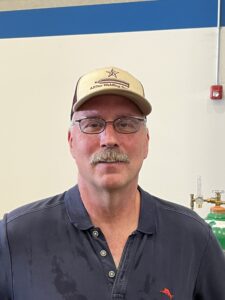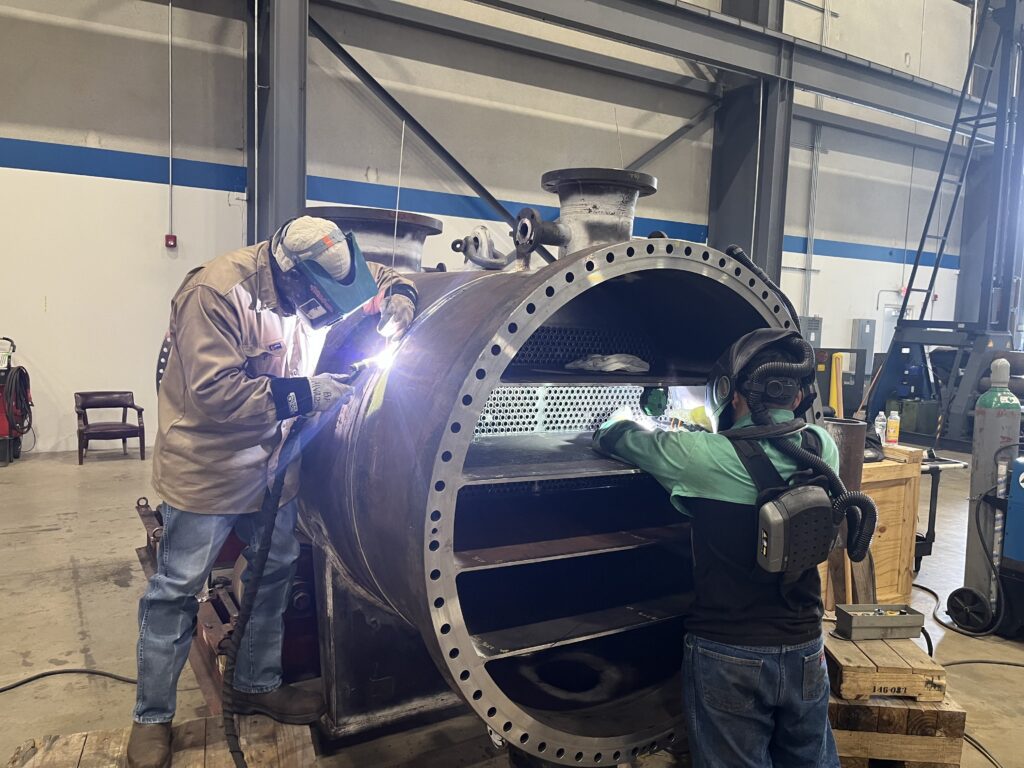John Knowles, Operations Manager, and Doug Ketron, Welding Engineer, both work in the pressure vessel heat exchanger (PVHEX) division of Logan Industries. In this interview, John and Doug discuss the main challenges faced in the PVHEX shop, how they overcome them, and the key to working successfully with clients.
Text and images courtesy of Logan Industries
Can you describe your background before you joined Logan?

John: My job duties are to oversee and coordinate the efforts of the PVHEX shop, as well as linking with the machine shop and weld shop. I started out fitting welding and pressure vessels and now have more than 35 years of experience in fabrication. After working as a machinist in the nuclear power generation industry, I came to work for Logan to help bring the new PVHEX facility online.
Doug: I’m a welding engineer for the pressure vessel heat exchanger shop, and also for our carbon steel services. I hold a degree in welding engineering from Ohio State University, which is the only accredited welding engineering school in the US. Here at Logan I help develop welding procedures and train our shop floor operatives on a range of equipment. The product range is diverse so we work on hydraulic cylinders and pressure vessels, as well as the structural work that we do to support the pressure vessels. The material range is also wide. Here, we’re doing titanium work for heat exchangers along with a variety of services, bringing more opportunity to work with the same exotic metals I’ve worked with in the past.

What capabilities does the pressure vessel shop offer?
Doug: The new building that’s been added is divided in half: half for the pressure vessel side and half for the carbon steel side. We’ve also made a significant investment in the capital equipment. On the heat exchanger side, we’re working on tube sheet that’s clad. We have the ability to clad and perform our procedure development here. In-house management has also made the investment in capital equipment for welding on the shop floor and for other tools. We’re working with equipment that’s new and gives us functionality relative to what we’re doing. We’ve added welding equipment that produces low heat input. The lower we can keep heat input when welding helps us mitigate distortion.
John: We’re also taking the time to invest in our people. We’re selecting our employees, and taking the time to invest what is required for them to be their very best. We are beginning to train with the CMT machines as soon as the machines arrive.
Doug: The cold metal transfer equipment also has multiple functionalities. We can perform straight pulse welding or straight DC welding, and we can also do combinations of CMT and pulse. The biggest issue lies in mitigation of distortion. When we’re doing cladding on carbon steel material, such as a carbon steel tube sheet, we also want to mitigate the amount of dilution into the carbon steel, thus pulling a minimum of iron content or ferrite up into the cladding layer, which is typically a corrosion-resistant layer. We’re trying to avert corrosion in service. For example, we want to have a content of iron typically between 5 and 10 percent for Inconel clad tube sheets. If it’s cladding in subsea piping, then we want to be below 5 percent. We are also seeking to get the iron content as low as possible in those types of corrosion resistance incidents in case we need it at a lower or different level within the cladding.

What challenges have you encountered in the pressure vessel shop? How did you overcome them?
John: We currently have two exchangers in the facility where the customer wanted our sister company Schelde to weld the tube-to-tube sheet joint. To do so, we brought two gentlemen over from the Netherlands to personally train and weld the tube sheet. They also introduced our US team to orbital welding, as well as how to program and set up the machine and equipment. The Netherlands team have shown our employees how to run our plate roll, allowing us the ability to start rolling our own cylinders.
Doug: We’re getting ready to do a new tube-to- sheet qualification, and heat exchangers is one of Schelde’s primary products. As one integrated company, under ASME section IX, we’re able to use each other’s welding procedures. This collaborative approach minimizes the time required to complete a qualification.
What do you think is the key to success when working with clients?
John: Build trust and most importantly, honesty. If you’re open, honest, upfront, and direct with them, you’ll build a very strong and trusting relationship.
Doug: We have a weekly meeting or conference call with our clients, as well as between ourselves. If we don’t know what the solution is immediately, we figure it out. We always treat our customers as we would like to be treated.
What is the biggest challenge that Logan is facing?
John: The biggest challenge is getting the people here that know what to do, that are willing to accept training and then can be trained to be excellent.
Doug: Word of mouth is the biggest way we go about finding talent as it’s usually the most reliable. The second method is recruiters, because they have the same avenues that they can pursue. However, whichever method we employ, it’s vital to find the right candidates. We seek the correct skill set and ability to interface cleanly into our staff and structure.

What goals are you working towards achieving at Logan?
John: I teach my team about what we do and why we do it. I go out to the welders every day and look at their welds, while offering guidance and coaching to improve further. I also coached our fitters on ways we need to do certain things because with heat exchangers, you have to grind all your internal welds flush to be able to put your tube bundle in– something that some people aren’t accustomed to. My goal every day is to help make our employees better today than they were yesterday. If you have a team that feels included in the business, they will return the same loyalty that you have instilled in them. When you’re in a bind and you need help, they’ll do it without a second thought. It’s that combination of leadership and loyalty.
Doug: I come from a background of business process improvement, which involves everybody in the facility. Whether it’s office processes or shop floor processes, there’s a methodology to make improvements that involves the whole company. If people are trained in business process improvement as well, then they won’t be afraid to speak up when something is wrong. If you can accomplish that, then you increase your productivity and reduce your costs.
What are you currently working on and what do you expect to be working on in the near-, mid- and long-term in terms of types of projects?
John: We’ve got a new project coming up at a pilot chiller. It’s going to be something unique as it is not a pressure vessel or heat exchanger. I’m looking forward to working on this project as it’s something that could dramatically benefit our portfolio. There are more of these around the country and people are always looking for the best in the business. With the technologies we’re bringing in and the skills that we have, I’m looking very forward to making this project a success. My goal as an operations manager is to build a facility that can seamlessly run 24-hours, seven days a week.
Doug: This new chiller project is heavily dependent upon our engineering team for design and drawings. We really have an great design and engineering department with the capability to put Logan in a position to go after new projects. In this particular case, we’re building a prototype first before we build the final equipment. Our team is able to answer questions and make changes based on customer input. If things get to the shop floor and we have an issue, our team is ready with innovative solutions. They use a lot of horsepower, putting Logan in a position to extend our reach beyond the standard pallet of products.
About the company
Logan Industries is a hydraulic repair, manufacturing and rental company serving the marine, industrial, mill, dredging, steel and oil and gas industries. Based in Hempstead, Texas, Logan has three domestic service locations and two international service locations.

